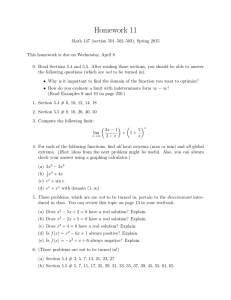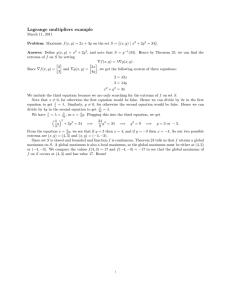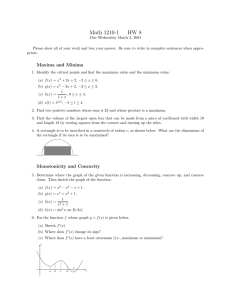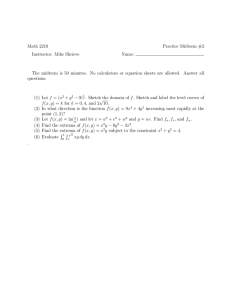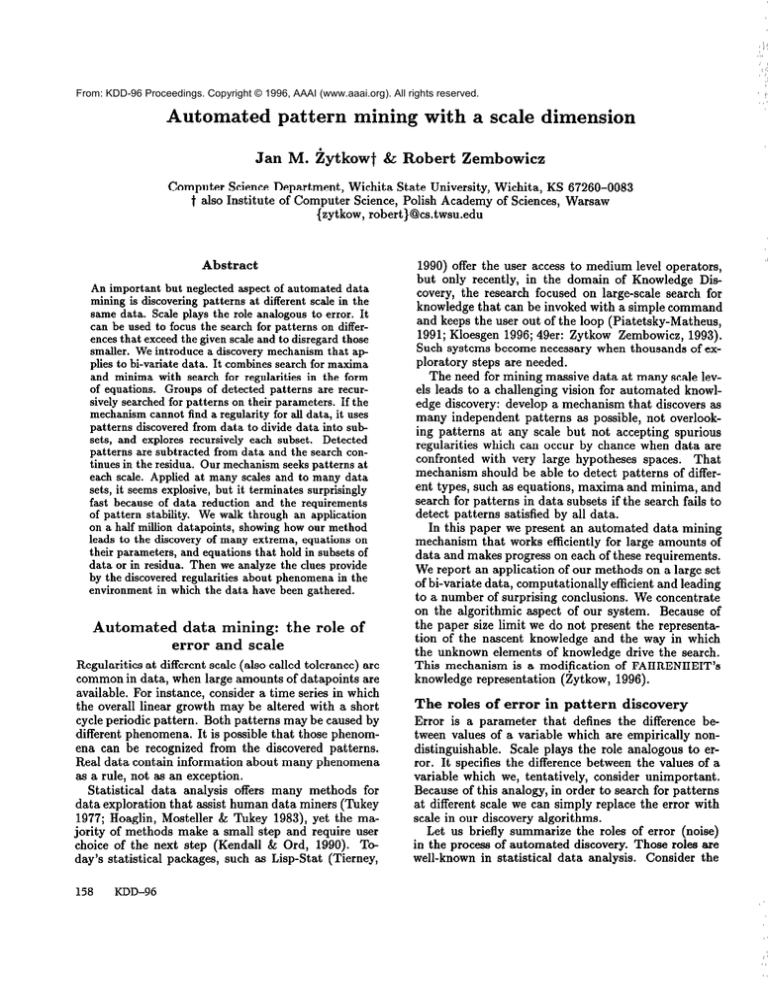
From: KDD-96 Proceedings. Copyright © 1996, AAAI (www.aaai.org). All rights reserved.
Automated
pattern
zan
&j
mining
i4-l-.A
. uy
blL”W
,
with
9, D-l..+....+
QL. ILUUCI
a scale dimension
rls..-.-.l..--.:-m
L LlellluuwlL~
Computer Science Department, Wichita State University, Wichita, KS 67260-0083
i also Institute of Computer Science, Polish Academy of Sciences, Warsaw
{zytkow, robert}@cs.twsu.edu
Abstract
An important but neglected aspect of automated data
mining is discoveringpatterns at different scalein the
Sitllle
data.
8C&
DhVS
the
r&
ar?&ZOUS
to er21X,
It
can be used to focus the search for patterns on differences that exceed the given scale and to disregard those
smaller. We introduce a discovery mechanism that ap
plies to bi-variate data. It combines search for maxima
and minima with search for regularities in the form
of equations. Groups of detected patterns are recursively searched for patterns on their parameters. If the
mechanism cannot find a regularity for all data, it uses
patterns discovered from data to divide data into subsets, and explores recursively each subset. Detected
patterns are subtracted from data and the search continuesin the residua. Our mechanismseeks patterns at
each scale. Applied at many scales and to many data
sets, it seemsexplosive,but it terminatessurprisingly
fast becauseof data reduction and the requirements
of pattern stability. We walk through an application
on a half million datapoints, showing how our method
leads to the discovery of many extrema, equations on
their parameters,and equationsthat hold in subsetsof
data or in residua. Then we analyze the clues provide
by the discoveredregularitiesabout phenomenain the
environment
Automated
in which the data have been gathered.
data mining:
the role of
error and scale
Regularities at different scale (also called tolerance) are
common in data, when large amounts of datapoints are
available. For instance, consider a time series in which
the overall linear growth may be altered with a short
cycle periodic pattern. Both patterns may be causedby
different phenomena. It is possible that those phenomena can be recognized from the discovered patterns.
Real data contain information about many phenomena
as a rule, not as an exception.
St&c&ic~ data
anrrlvair
--..- -----.f
--- offers Illany m&J&r for
data exploration that assist human data miners (Tukey
1977; Hoaglin, Mosteller & Tukey 1983), yet the majority of methods make a small step and require user
choice of the next step (Kendall & Ord, 1990). Today’s statistical packages, such as Lisp-Stat (Tierney,
158
KDD-96
1990) offer the user accessto medium level operators,
but only recently, in the domain of Knowledge Discovery, the research focused on large-scale search for
knowledge that can be invoked with a simple command
and keeps the user out of the i00p (Piatetsky-Matheus,
1991; Kloesgen 1996; 49er: Zytkow Zembowicz, 1993).
Such systems become necessary when thousands of exploratory steps are needed.
The need for mining massive data at many scale levels leads to a challenging vision for automated knowledge discovery: develop a mechanism that discovers aa
many independent patterns as possible, not overlooking patterns at any scale but not accepting spurious
regularities which can occur by chance when data are
confronted with very large hypotheses spaces. That
mechanism
-----------Lee_
qhmllrl
L___-_-
ha
-- nhle
----
tn
2- detect
v-4..-.,
nattwna
rld” -___I nf
-. differ-... _-
ent types, such aa equations, maxima and minima, and
search for patterns in data subsets if the search fails to
detect patterns satisfied by all data.
In this paper we present an automated data mining
mechanism that works efficiently for large amounts of
data and makes progress on each of these requirements.
We report an application of our methods on a large set
of bi-variate data, computationally efficient and leading
to a number of surprising conclusions. We concentrate
on the algorithmic aspect of our system. Because of
the paper size limit we do not present the representation of the nascent knowiedge and the way in which
the unknown elements of knowledge drive the search.
This mechanism is a modification of FAHRENHEIT’s
knowledge representation (Zytkow, 1996).
The roles of error in pattern discovery
Error is a parameter that defines the difference between values of a variable which are empirically nondistinguishable. Scale plays the role analogous to error. It specifies the difference between the values of a
variable which we, tentatively, consider unimportant.
RP,TII.W nf
analnvv
--“-IIv
-* this
...--- -“-‘
..bJ,
in
aearph fnr
aa- nrrler
----a tn
1., ---a.,*.
*WI nat+mna
yuv”v*Y.,
at different scale we can simply replace the error with
scale in our discovery algorithms.
Let us briefly summarize the roles of error (noise)
in the process of automated discovery. Those roles are
well-known in statistical data analysis. Consider the
”
data in the form D = { (zi, gi, ei) : i = 1, . . . , N}. Consider the search for equations of the form y = f(z) that
fit data (zi, yi) within the accuracy of error ei. For the
same ((Zi, vi) : i = 1, . . . . N}, the smaller are the error
values ei, i = 1, . . . . N, the closer fit is required between
data and equations. Even a constant pattern y = C
can fit any data, if error is very large, but the smaller
is the error, the more complex equations may be needed
to fit the data.
The same conclusions about error apply to other patterns, too. Let us consider maxima and minima. For
the same data (zi, yi), when the error is large, many differences between the values of y are treated as random
fluctuations within error. In consequence, few maxima
and minima are detected. When the error is small,
however, the same differences may become significant.
The smaller is the error, the larger number of maxima
and minima shall be detected.
Knowledge of error has been used in many ways
during the search conducted by Equation Finder (EF:
Zembowicz & iytkow, 1992):
1. The error is used in the evaluation of each equation y = f(z). For each datum, O.&i = ui can be interpreted as the standard deviation of the normal distribution N(g(zi), a,:) of y’s for each zi, where ~v(ziJ
-\ -, is the
mean value and ui is standard deviation. Knowledge
of that distribution permits to compute the probability
that the data have been generated as a sum of the value
y(zi) and the value drawn randomly from the normal
distribution N(0, ai), for all i = 1, . . . , N.
2. When the error ei varies for different data, the
weighted x2 value [(vi - f(zi))/0.5ei]2 is used to compute the best fit parameters for any model. This enforces better fit to the more precise data.
3. Error is propagated to the parameter values of
f(z). For instance, EF computes the error e, for the
slope a in y = az. When patterns are sought for those
parameters (e.g., in BACON-like recursive search for
multidimensional regularities), the parameter error is
used as data error.
4. If the parameter error is larger than the value of
that parameter, EF assumes that the parameter value
is zero. When y = az + b and [al < e,, then the
equation is reduced to a constant.
5. EF generates new variables by transforming the
initial variables 2 and y into terms such as log(t). Error
values are propagated to the transformed data and used
in search for equations that apply those terms.
Phenomena
at different
scale
When we collect data about a physical, social or economical process, it is common that the data capture
phenomena at different scale. They describe the process, but the values may be influenced by data collection, instruments behavior, and the environment. Different phenomena can be characterized by their scales
in both variables. Periodic phenomena, for instance,
can have different amplitudes of change in y and differ-
ent cycle length in 2. In a time series (8 is time) one
phenomenon may occur in a daily cycle, the cycle for
another can be few hours, while still another may follow a monotonous dependence between x and y. Each
phenomenon may produce influence of different scale
on the value of y.
Each datum combines the effects of all phenomena.
When they are additive, the measured value of y for
each x is the total of values contributed by each phenomenon. Given the resultant data, we want to separate the phenomena by detecting patterns that describe
each of them individually. The basic question of this
paper is how can it be done by an automated system.
Suppose that a particular search method has captured a pattern P in data D. Subtracting P from D
produces residua which hold the remaining patterns.
Repeated application of pattern detection and subtraction can gradually recover patterns that account for
several phenomena. In this process, one has to be cautious of artifacts generated by spurious patterns and
propagated to their residua.
It is a good idea to start the search for patterns from
large scale phenomena, by using a large value of scale in
pattern finding. The phenomena captured at the large
values of error follow simple patterns. Many smaller
scale patterns can be discovered later, in the residua
obtained by subtracting the larger scale patterns.
The roles for maxima and minima
In this paper we concentrate on two types of patterns: maxima/minima, jointly called extrema, and
equations. We explore the ways in which the results
in one category can feedback the search for patterns of
the other type.
A simple al orithm can detect maxima and minima
at a given seaPe 6:
Algorithm:
Find Extrema
(X,,,
, Y,,,)
and (X,,,,
Y,,,,,)
given ordered sequence of points (I,, y,), i = 1 . . N, and scale 6
task -unknown,
Xm., -xl,
Xm,, + XI, Ym.o + yl , Ym,, - yl
for
i &am 2 to N do
if task # max and y, > Y,,, + 6 then
store minimum (X,,,,
Y,,,)
tad-m=,
Xm,, + z,, Ymaz + Y,
else if task # min and y, < Y,,,,= - 6 then
store maximum (X,.,,
Y,,,)
task + min, X,,,, - I,, Y,,,,,, + y,
else if. Y, > I’,,,
then Xmas + I., Ymaz - Y,
else If y, < Y,,, then Xmln t m,, Y,,, - y,
if ym,* - Y,,,,,, > 6 then ; handle the last extremum, if any
if task = min then store minimum (X,,,,
Y,;,)
else if task = max then store maximum (X,.,,
Y,,,)
Our discovery mechanism uses maxima and minima
detected by this algorithm in several ways. First, if
the number of extrema is M, then the minimum polynomial degree tried by Equation Finder is M + 1. A
I, .~~...
degree higher than 1~1
may LDe --1L~----L~1-ulrlmately --.3-J
neeaeu, because the inflection points also increase the degree of
the polynomial. As the high degree polynomials are
difficult to interpret and generalize, if IL/f > 3, only the
periodic functions are tried.
Another application is search for regularities on different properties of maxima and minima, such as the
Pattern-OrientedData Mining
159
location, and height. Those regularities can be instrumental in understanding the nature of a periodic phenomenon. A regularity on the locations of the subsequent maxima and minima estimates the cycle length.
A regularity on the extrema heights estimates the amplitude of a periodic pattern. Jointly, they can guide
the search for sophisticated periodic equations.
Still another application is data partitioning at the
extrema locations. Data between the adjacent extrema,
detected at scale 6, are monotonous at 6, so that the
equation finding search similar to BACON1 (Langley et
al., 1987) applies in each partition. We use EF, limiting
1,. searcn
---.~-1-to
I- I!-~~~equations and term transformations
me
nnear
to monotonous (e.g., 2’ = log%, 2’ = exp 2). Since all
the data in each partition fit a constant at the tolerance
level l/2 x 6, EF is applied with the error set at 1/3x 6.
Data reduction
The search for extrema at all scales starts at the minimum positive distance in y between adjacent datapoints, or the error of y, if it is known. The search
uses the minimum difference between the adjacent extrema as the next scale value. The search terminates
at
ncale -4
at whirh
nn mrt.wma
-2 the
2-a.. firnt
_._I 2 I--.. . . ..-.. ..-.-“.-...Y
have hmn
..V.”
““VY fnrlnll
.V.......
Since an extremum at a larger scale must be also an extremum at each lower scale, when the search proceeds
from the low end of scale, the extrema detected at a
given scale become the input data for the search at the
next higher scale. This way the number of data is reduced very fast and the search at all levels can be very
efficient. The whole search for extrema at each scale
typically takes less than double the time spent at the
initial scale.
Algorithm:
Detect axtrema at all tolerance levels
Given an ordered sequence of points (z,, y,), i = 1.. . N,
Jnin + Imin(y, -Y,+I)~,
for all Y. # Y,+I, i = l...N
data + (I,, y;), i = 1. . . N
6+&n,,,
while data includes more than two points do
(X mrn/mors Ymin/mar ) in data at *de
Find Extrema
6
Store 6 , store list-of-extrema (Xmlrrjmo+, Y,,,,,,,)
6+6+&n,,, data + list-of-extrema (X,,,irrlm.=, Y,,,,,/,.,)
The search for equations may benefit from another
type of data reduction. A number of adjacent data, at
a small distance between their z values, can be binned
together and represented by their mean value and standard deviation. The size of the bin depends on the tolerance level in the x dimension. The results of binning
are vrsualized in Figures i and 2. Each pixei in the z
dimension summarizes about 500 data, so that about
0.5 mln data have been reduced to about 1000.
Pattern stability
No scale is a priori more important than another, as
patterns can occur at any scale. When the search for
patterns is successful at scale 6, the same pattern can
often be detected at scales close to 6. Patterns that
hold at many levels are called stable (Witkin, 1983).
Consider the stability of extrema. Each extremum that
nr.r,,rCl
“““U.”
160
St u!A (y-V.4
&van
uv
KDD-96
level
.V.U.
n-mat
at La..
-11 lnlupr
. ..UYY 2Lan
.m.- rePP1IF
““IU.
uu
I....“.
levels, L---...l~
Ctabilitv -==..-annli~
tn
nf
PY*FG~~
-‘- n&n
=-‘--- di~~e~~t.
--ill--Y”
-....*w.....
and is measured by the range of scale levels over which a
given min/maxpair is detected as adjacent. Expanding
the definition to the set of all extrema at a given scale,
we measure stability as the range of scale levels over
which the set of extrema does not change.
Stability is important for several reasons. (1) As discussed earlier, when a number of extrema are detected
at a given scale, regularities can be sought on their location, height, and width. It is wasteful to detect the
same regularities many times at different scales and
then realize that they are identical. A better idea is
to recognize that the set of extrema is stabie over an
interval of scale levels, and search for regularities only
once. (2) A stable pattern is a likely manifestation of
a real phenomenon, while an unstable set of extrema S
may be an artifact. Some extrema may be included in
S by chance. A slight variation in the tolerance level
removes them from S. The search for regularities in
such a set S may fail or lead to spurious regularities.
It would be a further waste of time to seek their interpretation and generalization.
Since regularities for extrema may lead to important
conclusions about the underlvine
Phenomena.
~~”~~~~r---------__-, our
--. qvs“+tern pays attention to sets of extrema which are stable
across many tolerance levels. It searches the sets of extrema and picks the first stable set at the high end of
scale.
Algorithm%
Detect stable set of extrema at high end of scale
Given a sequence of extrema sets EXTREMA,,
ordered by 6,)
6min 5 6%I6maa :
for 6 from 6.,....
.-. .- to 6,,,.._- - do
Compute the number E, of extrema in EXTREMA,
for each different E, do
Compute the number N, of occurrences of E, ;; The higher
;; is N,, the more stable the corresponding set EXTREMA,
Let N,, Nb two highest numbers among N, return EXTREMA,
for the minimum(&)
&,)
;; That among two most stable sets which is of higher scale
and return 6,:Dbrc = average(6) for EXTRRMA,
Residual data
Our mechanism treats patterns as additive. It subtracts the detected patterns from data and seek further
patterns in the residua. We will now present the details
of subtraction and discuss termination of the search.
Both equations and extrema are functional relationships between x and y: y = f(z). Some extrema can be
described by equations that cover also many data that
extend far beyond a given extremum. For instance,
a second degree polynomial that fits one extremum,
may at the same time capture a range of data. Equations may not be found, however, for many extrema.
Those we represent point by point. In the first case,
when 2/ = f(z) is the best and acceptable equation, the
residua are computed as ri = gi -f(~i), and they oscillate around y = 0. In the second case we remove from
the data all datapoints that represent the extremum.
In the first case the data are decomposed into pattern
y = p(z) and residua {(zi,ri),i
= 1,. . .,N}, SO that
,-SI~P
the
rlslt.2 .a.”
~WK.nawti&I;= f(g;) $ r;. .Tn. . the
“1.” ..uuv
mu.“.“I.” ~,~nnrl
““““..U
v-v,
tioned into the extremum ((sir vii) : s(zi)}, where s(z)
describes the scope of the extremum, and the residua
((G,
grams? Can our mechanism find enough clues about
chose patterns to discover the underlying phenomena?
$6) : 1t(G)}*
If the residua (Zi, Q) deviate from the normal distribution, the search for patterns applies recursively.
Eventually no more patterns can be found in residua.
This may happen because regularities in the residua are
not within the scope of search or because the residua
represent Gaussian noise. In the latter case, the final
data model is y = f(z)+N(O, E(Z), where E(Z) is Gaussian, while f(z) represents all the detected patterns.
Since the variability of residua is much smaller than
that of the original data, the subtraction of patterns
typically takes only a few iterations.
Algorithm:
Detect Patternm
D c the initial data
until data D are random
seek stable pattern(s) P in D at the highest tolerance levels
D + aubtract pattern(a) P from D
Data
As an example we will consider a large number of data
collected in a simple experiment. In order to find the
theory of measurement error for an electronic balance,
we automatically collected the mass readings of an
empty beaker piaced on the baiance. The measurements have been continued for several days, approximately one datapoint per second. Altogether we got
482,450 readings (7.2 megabytes). Fig. 1 illustrates the
data. The beaker weighted about 249.130mg. Since the
nominal accuracy of the balance is O.OOlg=lmg, we expected a constant reading that would occasionally diverge by a few milligrams from the average value. But
the results were very surprising. All datapoints have
been plotted, but many adjacent data have been plotted at the same value of 2.
We can see a periodic pattern consisting of several
large maxima with a slower ascent and a more rapid
descent. The heights of the maxima seem constant
or slightly growing, and they seem to follow a constant cycle. Superimposed on this constant pattern
are smaller extrema of different height. Several levels of even smaller extrema are not visible in Figure 1,
because the time dimension has been compresses, but
they are clear in the original data.
Upon closer examination, one can notice seven data
points at the values about 249.43Og, that is 0.3g above
the average result, a huge distance in comparison to
the accuracy of the balance. They can be seen as small
plus signs in the upper part of Figure 1. There is one
point about 0.3g below the average data. Those data
must have been caused by the same phenomenon because they are very speciai and very simiiar: they are
momentary peaks of one-second duration, at the similar distance from the bulk of the data.
Apparently, several phenomena must have contributed to those data. Can all these patterns be detected in automated way by a general purpose mechanism, or are our eyes smarter than our computer pro-
Results
of search for patterns
scales
at many
We will now illustrate the application of our multi-scale
search mechanism on the dataset described in the previous section.
Detect extrema
at all tolerance
levels:
The
search for extrema at all levels of tolerance started from
482,450 data and iterated through some 300 scale levels. Since the number of extrema decreased rapidly
between the low scale levels, the majority of time has
been spent on the first pass through the data. The
number of extrema at the initial scale of lmg has been
29,000, so the data have been reduced to 6%. The
number of extrema has been under 50 for 6 > 9mg.
Find the first stable set of extrema:
The algorithm that finds the first stable set has been applied to
all 300 sets of extrema. It detected a set stable at the
tolerance levels between 30 and 300. The number of extrema has been 17, including 8 maxima and 9 minima,
Eight of those are the outliers discussed in Section 2,
while the complementary extrema lie within the main
body of data. ‘The stabie extrema became the focus of
the next step. We will focus on the maxima, where the
search has been successful.
Use the stable extrema
set: A simple mechanism
for identification of similar patterns (iytkow, 1996) excluded one maximum, which differed very significantly
from all others in both the height and width (to limit
the size of this paper, we do not discuss the extrema
widths). That maximum is an artifact accompanying
the minimum located 3OOrng under the bulk of the
data. When applied to the remaining maxima, the
equation finder discovered two strong regularities: (1)
maxima heights are constant, (2) the maxima widths
are constant (equal one second). No equation has been
found for their location. Even if these l-second deviations from the far more stable readings of mass occurred only seven times in nearly half million data, the
pattern they follow may help us sometime to identify
their cause.
Subtract
patterns
from data:
Since the seven
maxima have the width of 1 datapoint each, according
to section 1.6 they have been removed from the original
data. 482,442 data remained for further analysis (one
single-point minimum has been removed, too).
Detect
patterns
in the residua:
The search
for patterns continued recursively in the residual data.
Now the extrema have been found at the much more
iimited range oftoierance levels, between i and 43. The
numbers of maxima at each scale have been depicted
in Table 1 in the rows labeled M,,,,,. The stability
analysis determined a set of five maxima and the corresponding minima, which have been stable at the scale
between 23 and 30. No regularity has been found for
extrema locations and amplitudes, but interesting regPattern-OrientedData Mining
161
+
*
+
Figure 1: The raw results of mass measurements on an electronic balance over the period of five days (482450
readings).
ularities have been found for heights and locations of
the maxima, from the data listed in Table 2.
Table 2: The first stable group of maxima, at the scale
23-30 in Table 1,
For those five maxima, stable equations have been
found for location and height as functions of the maxima number, M:
location = 86855M - 18261 and
height = 0.0026M + 249.144.
The successful regularities have been also found for
minima locations and heights. But no equation has
been found for all data at the tolerance level l/6 x
30mg = 5mg.
1DanC:+:rrrr
casYBY.“Y
thea
VYT
rlcs,m.
“-“a.
Gnra
VIIIbcI
n*
IX”
+,;.-Pr\nnma+r;F
“116”I.“I‘n,YI‘\r
equation has been found (cf. section 1.3), the data
have been partitioned at the extrema, and search for
monotonous equations has been tried and succeededin
each partition, with different equations. For instance,
in two segments of data: down-l (in Figure 2, data for
X from about 70,000 to about 90,000) and down-2 (X
from 160,000 to 180,000), the equations are linear:
(segmentdown-l)
y = -1.61 x lo-’ x x + 249.249
(segmentdown-2) g = -1.46 x lo-’ x z + 249.371
162
KDD-96
By subtracting these regularities from the data, two
sets of residua have been generated, labeled down-l and
down-2. Further search, applied to residua in each partition, revealed extrema at lower tolerance levels. The
patterns for the stable maxima locations as a function
of maxima number M, for instance, have been:
(segmentdown-l)
location = 1220 x M + 70,425
(segmentdown-a) location = 1297 x M + 154,716
The slope in both equations indicates the average cycle measured in seconds between the adjacent maxima.
That cycle is about 21 minutes (1260 seconds).
Physical
interpretation
of the results
How can we interpret the discovered patterns? Recall
that the readings should be constant or fluctuate minimally, as the beaker has not changed its mass.
wp
&
&
knnw
____-.. what
.._- -1 cannerl
------
the
1--- one-!-necnnd
---- -----_ - ertrema.
___1------
at the highest scale. Perhaps an error in analog-todigital conversion. But we can interpret many patterns
at the lower levels. Consider the linear relation found
for maxima locations, location = 86855M - 18261. It
indicates a constant cycle of 86,855 seconds. When
compared to 24 hours (86,400 seconds), it leads to
an interesting interpretation: the cycle is just slightly
longer than 24 hours. The measurements have been
made in May, when each day is few minutes longer then
the previous one. These facts make us see a close match
-=
E
.-.----
-1
=
---
---.
z
z
=
7
:
:
z
1:
: ==-__
.-:.= ._-_=5
-_
i--l---.!--.
have been snhtrncted.
SCdC
Mmaz
SC.&
Mmm
1
14337
23
5
2
3114
24
5
3
2308
25
5
4
808
26
5
5
617
27
5
6
267
28
5
7
204
29
5
8
78
30
5
9
46
31
4
10
26
32
3
Table 1: The number of maxima (M,,,)
between the cycle of day and night and the maxima and
minimain the data. The mass is the highest at the end
of day. It goes sharply down through the night, which
is much shorter than the day in May. Then the mass
goes slowly up during the day, until the next sunset.
Why would the balance reflect the time of the day
with such a precision? Among many possible explanations we can consider temperature, which changes
in a daily cycle. The actual changes in temperature
at the balance did not exceed one centigrade and have
been hardly noticeable, but if this hypothesis is right, it
should apply to other patterns discovered in the same
data. The balance has been located in a room with the
windows facing east and the morning sun raising temperature from early morning. What about the short
term cycles of about 20 minutes? The air conditioning seems the culprit. It turns on and off about every
15-25 minutes, in shorter intervals during the day, in
longer intervals at night. The regularities in maxima
locations in different data partitions reveal that pattern. The room has been under the influence of both
the air-conditioning and from the outside, which explains both the daily cycle and the short term cycle.
We could not confirm these conclusions by direct measurements. Few weeks later our discovery lab has been
m,wswl
AII”.bU
tn
snnthrar
“V cu.“UI.“.
hr,;l,-l;ntr
YU..U...~.
Acknowledgment:
special thanks to Jieming Zhu for
his many contributions to the researchreported in this
paper.
11
22
33
2
12
16
34
2
13
15
35
2
14
15
12
12
36
37
11111
16
11
38
17
7
39
18
7
40
19
7
4;
20
7
4;
21
6
4;
22
6
found for different scale values.
References
Hoaglin, D.C., Mosteller, F., & Tukey, J.W. 1983. Understanding Robust and Exploratory Data Analysis, John Wiley
L Sons, New York
Kendall, M. & Ord, K. 1990. Time Series, Edward Arnold
Publ.
Klijsgen, W. 1996. Explora: A Multipattern
and Multistrategy Discovery Assistant, in U.Fayyad, G.PiatetskyShapiro, PSmyth
& R.Uthurusamy
eds.
Advances in
Knowledge Discovery and Data Mining, AAAI Press, 249271.
Langley, P., Simon, H., Bradshaw, G. & Zytkow, J. 1987.
Scientific Discovery:
Computational
Explomtions
of the
Creative Processes. MIT Press: Cambridge, Mass.
Piatetsky-Shapiro:
G. and C. Matheus, 1991. Knowledge
Discovery Workbench, in G. Piatetsky-Shapiro
ed. Proc. of
AAAI-91 Workshop on Knowledge Discovery in Databases,
11-24.
Tierney, L. 1990. Lisp-Stat: An Object-Oriented Environment for Statistical Computing and Dynamic Graphics, Wiley, New York, NY.
Tukey, J.W. 19’77. Exploratory Data Analysis, AddisonWesley, Reading, MA.
Witkin, A.P., 1983. Scale-Space Filtering, in Proc. of Intl.
Joint Conj. on Artificial Intelligence, AAAI Press.
Zembowicx, R., & Zytkow, J.M. 1992. Discovery of Equations: Experimental Evaluation of Convergence, in Proc. of
10th National Conference on Artijicial
Intelligence, AAAI
Press, 70-75.
Zytkow, J.M. 1996. Automated
Discovery
Laws, to appear in findamenta
Informatica.
Pattern-Oriented
of Empirical
Data Mining
163


